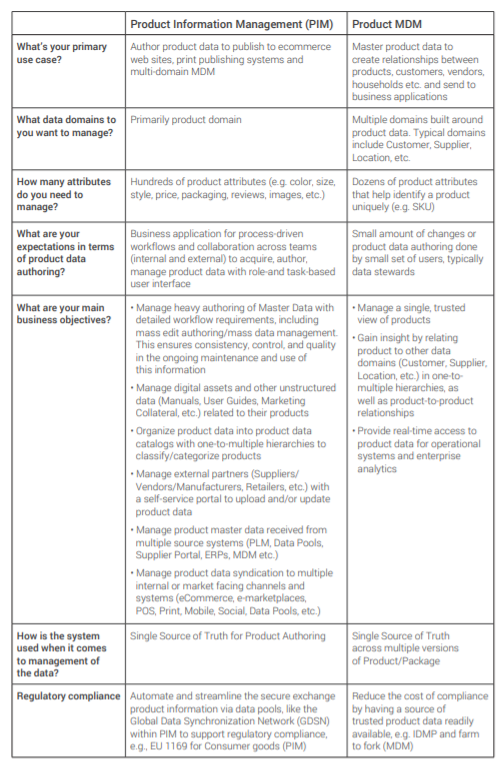
As data volumes explode, business models change, digital commerce grows significantly and new sales channels emerge, having trusted product data is more crucial than ever before. At the same time, remaining competitive while delivering exceptional customer experiences across any touchpoint requires an agile, scalable, and flexible solution for trusted and relevant product data.
Organizations across industries have recognized product data as a strategic asset at the executive level. The increasing investment in master data management means many organizations are now challenged to choose the right strategy for creating a single, trusted view of master data. In the area of product master data management, this choice is leading to confusion. Specifically, the difference between product master data management (Product MDM) and product information management (PIM) technologies, at least superficially, appears subtle.
What Is Product Information Management (PIM)?
A product information management (PIM) solution is a business application that centralizes the management of product data and digital assets and streamlines collaborative data enrichment. It helps standardize and automate the increasingly complex demands of product information management and syndicates trusted, enriched and high-quality product information to customer touchpoints, sales, and marketing channels.
PIM improves cross-functional collaboration, streamlines critical workflows, and surfaces customer/sales opportunities that otherwise would have been hidden by disconnected, poor-quality product data.
Key Capabilities and Benefits of Product Information Management (PIM)
The main objectives of a PIM solution are to:
- Streamline collaboration on product content, both internally and externally (e.g., partners, suppliers)
- Automate product information management and approval workflows
- Speed up time to market for new products
- Improve omnichannel capabilities
- Publish consistent, relevant, and localized product content
- Fuel any channel with the right product information
- Expand the reach of sales and marketing into new channels
- Securely exchange product data via data pools
- Increase sales through:
- Delivering rich and complete product information and digital assets
- Creating an engaging customer experience and ongoing loyalty, thanks to trusted and relevant product content
- Improving up-sell and cross-sell opportunities
- Enabling higher conversion rates and margins
Drivers and Users of Product Information Management
Typically, the need for a PIM solution is driven by the sales or marketing organization. This demand arises as these divisions find they cannot adequately scale in their publication of increasingly complex content across the ever-increasing number of sales and marketing channels they must support. PIM users are normally performing a function directly related to a sales or marketing process. It will typically support a large number of internal and external (agency) users across a broad range of sales and marketing roles. With its strong focus on collaborative workflows, PIM allows multiple stakeholders to author a comprehensive set of product attributes needed by the business.
What Is Master Data Management (MDM)?
Product master data management (MDM) is the glue that binds an organization’s systems and information together. Mastering product data with MDM provides a single source of truth—based on trusted, accurate, complete product data—for any data-driven digital transformation across the business, including marketing and sales operations, omnichannel retailing, supply chain optimization, compliance initiatives, and more.
The primary purpose of MDM is to create relationships—between products, customers, vendors, employees, households, locations, and the like—and fuel analytical and operational business applications. Product data is managed within an MDM system, just like other business-critical data, with the intention of understanding the complete number and types of relationships.
With MDM, you can locate, access, and utilize trusted data exactly when and where it’s needed. To be able to support the end-to-end requirements of trusted product data, it should include the data quality, data integration, business process management, and data security capabilities that will enable you to:
- Acquire product, supplier, customer and other data quickly, no matter its source (on-premises, in the cloud, or from third parties)
- Gain visibility into data, relationship patterns, and variations—and make any necessary corrections
- Easily enrich master data records with data from external providers
- Create a trusted view and securely deliver product data for both analytical and operational use cases
MDM has a broader scope than a specific department or types of users. The recognition of a need for MDM could come from multipleplaces within an organization. Employees who recognize this need are typically trying to consolidate data across different functional or regional divisions in an organization.
Often the need is initially identified by IT, as they are frequently the ones who receive increasing requests to collect, cleanse, and cross-reference product data. Business users express the need for MDM using different terminology, all revolving around poor product data quality and low trust in any figures associated with product data (e.g.,sales, inventory, forecast, profitability). MDM spans multiple business objectives, departments, and lines of businesses across the organization. It helps organizations improve business operations by removing data inconsistencies that can seriously impact the business.
Key Capabilities and Benefits of Master Data Management
An MDM solution can help you:
- Access a trusted 360°-view of product data across the organization
- Avoid product launch delays
- Improve supply chain efficiencies
- Enable rapid supply chain traceability
- Stop lost revenue due to out-of-stocks
- Reduce customer defection because of poor service
- Reduce inventory levels
- Enable rich reporting and analytics environments to deliver informed decisions
- Consolidate product data from different systems
- Clear relationships (raw material and supplier; finished goods and sales regions)
- Achieve maximum ROI from M&As by streamlining corporate data consolidation to realize synergies more quickly
- Use accurate product data across the enterprise for your analytics, to better identify opportunities and increase value
- Boost business efficiency and IT performance by automating data profiling, discovery, cleansing, standardizing, enriching, matching, and merging in a single central repository
- Share and manage product master data strategically and securely across functions, channels, lines of business, regions, and applications
Do I Need a PIM or MDM to Master Product Data?
The path to value should be based on your organization’s most pressing business challenges: What business challenge do you want to address by improving your management of product data? The below comparison table “PIM vs. Product MDM” highlights the typical business value delivered by each solution:

PIM and MDM: A Powerful Combination
Sometimes, organizations decide to leverage both PIM and MDM. They may start with one solution and then add the other. They realize that to support their use cases and future master data strategy, they will need a combination of both capabilities. In this case, MDM and PIM enable a product master data ecosystem that delivers the capabilities and business values listed earlier in this article.
PIM serves as the business application for collaboration on product authoring, syndicating data to external systems and sales channels. But, it can also feed the MDM with accurate product content, so it maintains the Product Golden Record. Additionally, as an example, MDM can also complete the part of material data mastering.
MDM serves as the foundation to hierarchy, and enables reporting, analytics, and internal system processes. MDM will help your organization understand how many products the company sells, while PIM can serve as a collaborative product content management platform with more details about the products, variants, and assortments.
There is one key concept to remember when working with MDM and PIM solutions in tandem: Data should only be included in an MDM solution if there is a need to share the data broadly across multiple systems (e.g., internal, analytical, external, supply chain). With this concept in mind, you can accept that some of the product data will have its source and “golden record” outside of MDM. Specifically, the PIM system becomes the golden record for a large portion of the sales and marketing data that fuels most external channels.
Learn More About PIM and MDM
For more information, check out these analyst reports:




